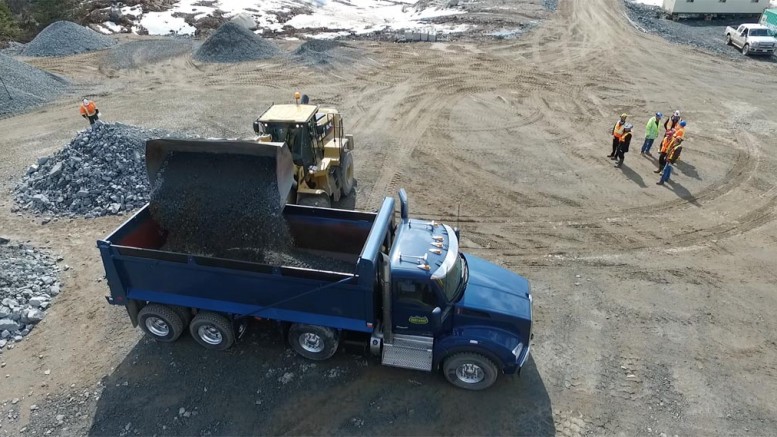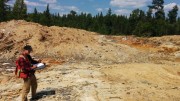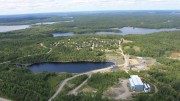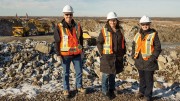Harte Gold (TSX: HRT; US: OTC: HRTFF) says the 70,000-tonne bulk sample underway since April at its Sugar zone deposit in northern Ontario is going smoothly, and it has applied for permission from the Ministry of Northern Development and Mines to mine another 30,000 tonnes under the program.
The 70,000-tonne bulk sample should be done by February 2017, and if the company gets a permit to mine another 30,000 tonnes under the program, more tonnes could be mined by the third quarter of 2017.
“It’s going well,” Stephen Roman, the company’s chairman, president and CEO, says in an interview. “We’ve completed the ramp to the bottom of the 70,000-tonne bulk sample area and opened up five levels … we started production ore-blasting on the 375 level using long-hole mining methods and the next level will be 360, and we’ll work our way down.”
Roman notes that the ramp is in the footwall, below the lower zone, and the company is cross-cutting into the orebody. “We open up development drifts on 15-metre levels, so most of all the development work has been completed now, and we’re starting to drill our long-hole stopes,” he says.

A 20-tonne truck exits a portal at Harte Gold’s Sugar gold project in Northern Ontario. Credit: Harte Gold.
The 70,000-tonne bulk sample should cost $20 million and mine only the Sugar zone — one of four zones the company has identified at the project, 60 km east of the Hemlo area gold mines and 25 km northeast of White River. The deposit is within 80 to 100 km of three operating mines — Barrick Gold’s (TSX: ABX; NYSE: ABX) Hemlo, Richmont Mines’ (TSX: RIC; NYSE-MKT: RIC) Island Gold mine and Wesdome Gold Mines’ (TSX: WDO) Eagle River mine.
The Sugar zone is a high-grade, 500,000 oz. gold deposit that is open at depth and on strike, where mineralization extends to 1,000 metres deep.
The ore from the bulk sample is being sent 80 km to Barrick’s Hemlo mill on the north shore of Lake Superior. Under the contract with Barrick, Harte’s ore must average 5 grams gold per tonne or higher, and so far Harte Gold has fulfilled that requirement.
In May, the first full month of ore shipments, the company sent 1,640 tonnes of development ore to the mill at an average grade of 11.54 grams gold per tonne. Shipments in June exceeded expectations. The company delivered 2,528 tonnes of development ore to Hemlo, which is far above its original forecast of 298 tonnes.
Tonnages and grade have held up, and the orebody looks continuous, Roman says.
“Our long-hole blasting to date has shown that the ore breaks cleanly from the hanging wall and the footwall, so there’s little, if any, dilution,” he says. “Our mining engineers are just ecstatic about the way it’s breaking off both the footwall and hanging wall — it’s a clean break, and it’s extremely positive about the mineability of the orebody.”
The purpose of doing another 30,000-tonne bulk sample would be to access the south side of the Sugar zone orebody so the company will be testing two areas (north and south) to better evaluate the deposit’s mineability by looking at widths, grades and the overall economics, Roman says.

George Flach, Harte Gold’s vice-president of exploration, examines ore face at the Sugar gold deposit. Credit: Harte Gold.
Assuming Harte Gold gets the approval, it will then have to negotiate a deal with Barrick’s Hemlo mill. If Barrick isn’t willing to take on more tonnes, Roman says, there are other options, such as milling in Timmins, 400 km away.
Harte Gold has also completed a geophysical survey that found a dozen targets between the Sugar zone and the Wolf zone, 2 km away.
“The Wolf zone was discovered using geophysics,” Roman says. “The current 5,000-metre drill program will test these targets and others identified around the Sugar zone deposit, with the intention of expanding the current gold resources on the property.”
Roman hopes for a larger resource for the project by year-end.
In addition to the bulk-sample work and the 5,000-metre drill program, the company is proceeding with commercial production permitting initiatives and finishing baseline studies, test pitting for the tailings impoundment area and working on on-site mill design.
Roman says the company is well financed with $5 million in its treasury, and has cash flow from the bulk-sampling program, which he says could produce 24,000 oz. gold this year.
In July, the company raised $4.1 million in a private placement of 13.5 units (one share and one share purchase warrant) at 30¢ a unit. Most of the funds — $3 million of the $4.1 million — came from a strategic investor at Toronto-based merchant bank JJR Private Capital.
“They’ve had a number of successes with other business ventures, and decided they wanted to get into the mining space,” Roman says. “They liked the Harte Gold story and the undervalued nature of our shares, so they bought stock in the market, and approached us to do a private placement.
“We’re in Ontario, we’re right beside three operating mines, we’re milling at Barrick — which is the biggest gold company in the world — our shares are undervalued, and we have huge exploration potential on the property. So they said: ‘Hey, this is a good opportunity.’”
The Sugar zone contains an indicated resource of 980,900 tonnes grading 10.13 grams gold per tonne (uncapped) — or 8.72 grams gold (capped) — for 319,300 oz. gold (uncapped), or 275,000 oz. gold (capped).
Inferred resources add 580,500 tonnes averaging 8.36 grams gold (uncapped) — or 7.03 grams gold (capped) — for 156,000 oz. gold (uncapped), or a capped 131,300 oz. gold.
The company says there is much more exploration beyond the Sugar zone. Harte discovered its Wolf zone in 2010 with a 7.5-metre intercept grading 9.5 grams gold, including a higher-grade core of 3 metres averaging 22.9 grams gold. Drilling in 2015 extended the Wolf zone down-plunge and on strike.
In 2014, an induced-polarization magnetic survey found a mafic volcanic and sedimentary contact. Drilling the next year confirmed a Hemlo setting, with pathfinder elements and gold values that the company named the Contact zone.
In 2015 the company found the fourth zone at Sugar — called the Footwall zone.
Over the last year, Harte Gold’s shares have traded between 4.5¢ and 34.5¢. At press time the junior’s shares traded at 29¢ apiece.






Be the first to comment on "Harte Gold steps up work at Sugar near Hemlo"